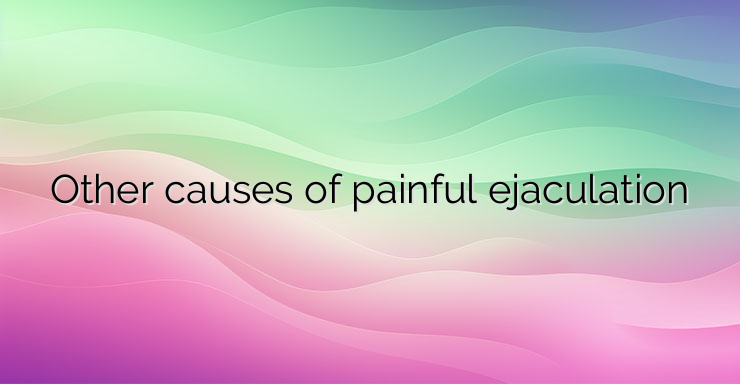What obstructive conditions cause painful ejaculation? Certain conditions can block the passage of seminal fluid. When the flow is obstructed during ejaculation, the increased pressure can cause severe stabbing pain and even bleeding from the urethra. Possible causes of obstruction include: Urethral stricture. This is a narrowing of the urethra caused by infection, injury, or inflammatory disease; Obstruction of the ejaculatory duct. Blockage of the ejaculatory duct (which transports sperm to the urethra) can occur with a urinary tract infection, urinary tract cysts, or epididymitis; Concretions in the seminal vesicles. Like kidney stones, these are hardened deposits of minerals that can block the seminal vesicles (specialized glands that produce seminal fluid); Recovery after inguinal hernia surgery. Inguinal hernia recovery can sometimes cause nerve compression and/or fibrosis or kinking of the vas deferens; Vasectomy. This surgical method of birth control blocks the flow of sperm by cutting or sealing the vas deferens (the vessel into which sperm travel from the epididymis); Radical prostatectomy. It is used in men with prostate cancer and involves surgical removal of the prostate gland, seminal vesicles and parts of the vas deferens. Irradiation of the pelvis. Radiation therapy, commonly used to treat prostate cancer, can cause fibrosis and narrowing of the vessels and ducts in the male reproductive system What neurological conditions cause painful ejaculation? Pudendal neuropathy, also known as pudendal neuralgia, is chronic pain caused by damage to the main nerve serving the pelvis, called the pudendal nerve. It is most often caused by a pinched or pinched nerve. During orgasm, the contraction of the ejaculatory muscles can cause pain, especially in the perineum and the lower part of the buttocks. About 1 in 4 men with pudendal neuropathy experience painful ejaculation. Causes of pudendal neuropathy include prolonged sitting, cycling, and horseback riding (usually for months or years). Chronic constipation and pelvic fractures can also lead to pudendal neuropathy. What medications can cause painful ejaculation? Painful ejaculation is commonly associated with certain classes of antidepressants used to treat depression and chronic pain. Stopping the medication usually relieves symptoms. Tricyclic antidepressants and selective serotonin reuptake inhibitors (SSRIs) are the two classes most commonly associated with painful ejaculation. Other side effects affecting sexuality include loss of libido (sex drive) and erectile dysfunction (inability to achieve or maintain an erection sufficient for sexual intercourse). Antidepressants known to cause male dysorgasmia include:Clomipramine; Amoxapine; Venlafaxine; Desipramine; Fluoxetine; Imipramine; Protriptyline Muscle relaxants with a similar chemical structure to tricyclic antidepressants, such as cyclobenzaprine, are also known to cause painful ejaculation. Are there tests to diagnose the cause of painful ejaculation? Because painful ejaculation is a nonspecific condition with many possible causes, diagnosis will begin with a history (review of medical history) and physical examination of the patient. Any medications the patient is taking and other symptoms they are experiencing will also be accounted for. As part of the physical exam, the specialist will examine the patient’s genitals and may perform a digital rectal exam, in which the doctor inserts his or her finger into the patient’s rectum to check for problems with organs or other structures located in the pelvis. Other common tests and procedures include: Prostate-specific antigen (PSA) test. This blood test detects a protein called prostate-specific antigen, the levels of which increase when the prostate gland is inflamed; Urine examination. This test evaluates a urine sample for evidence of infection, bleeding, high blood sugar, or kidney disease; Uroculture. This test is used to isolate and identify specific bacteria, fungi, or viruses by culturing (growing) them from a urine sample; Ultrasound of the pelvis. This non-invasive diagnostic technique uses reflected sound waves to obtain detailed images of internal organs, such as the testicles and epididymis; Transrectal ultrasound. This is a type of ultrasound examination in which a thin probe with an ultrasound wave transducer (transmitter/receiver) is inserted through the anus into the rectum (rectum), which can be used to visualize the prostate gland or to check for blockages. ejaculatory duct or seminal vesicles How to treat painful ejaculation? Treatment for painful ejaculation varies depending on the underlying cause. Treating the underlying cause often fixes the problem as well, and in some cases no other treatment is needed other than waiting for a while. There are several direct remedies for male dysorgasmia that achieve permanent results. However, if the cause cannot be found, the doctor may prescribe muscle relaxants, pelvic floor muscle exercises, anticonvulsants, or opioid medications to help minimize the problem. References: 1. Gray M, Zillioux J, Khourdaji I, Smith RP. Contemporary management of ejaculatory dysfunction 2. Parnham A, Serefoglu EC. Retrograde ejaculation, painful ejaculation and hematospermia 3. Wagar M, Omar K, Moubasher A, Brunckhorst O, Ahmed K. Painful ejaculation – an ignored symptom 4. National Institute of Diabetes and Digestive and Kidney Diseases. Definition and facts of bladder infection in adults 5. Verywell Health. Painful Ejaculation (Male Dysorgasmia)Painful Ejaculation (Male Dysorgasmia)


Leave a Reply